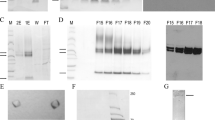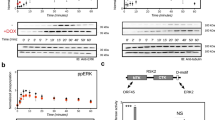Abstract
Immunoreceptor tyrosine-based activation motifs (ITAMs) are involved in the transduction of signals necessary for activation, differentiation, and survival in hematopoietic cells. Several viruses have been shown to encode ITAM-containing transmembrane proteins. Although expression of these viral proteins has in some cases been shown to transform nonhematopoietic cells, a causal role for a functional ITAM in this process has not been elucidated. To examine the potential transforming properties of ITAM-containing proteins, a recombinant protein consisting of ITAM-containing cytoplasmic regions of the B-cell antigen receptor was expressed in immortalized murine mammary epithelial and fibroblast cells. Mammary epithelial cells expressing this construct exhibited depolarized morphology in three-dimensional cultures. This transformed phenotype was characterized by a loss of anchorage dependence and hallmarks of epithelial to mesenchymal transition. Fibroblasts expressing this ITAM construct also lost contact inhibition and anchorage dependence. The transformed phenotype seen in both cell types was abrogated upon tyrosine to phenylalanine substitutions of the ITAMs. Inhibition of Syk tyrosine kinase, which associates with the ITAM, also prevented cell transformation. Our results indicate that expression of a nonviral ITAM-containing protein is sufficient for cell transformation. Despite lacking intrinsic enzymatic activity, ITAM-containing proteins can function as potent oncoproteins by scaffolding downstream mediators.
This is a preview of subscription content, access via your institution
Access options
Subscribe to this journal
Receive 50 print issues and online access
$259.00 per year
only $5.18 per issue
Buy this article
- Purchase on Springer Link
- Instant access to full article PDF
Prices may be subject to local taxes which are calculated during checkout







Similar content being viewed by others
References
Bannish G, Fuentes-Panana EM, Cambier JC, Pear WS, Monroe JG . (2001). J Exp Med 194: 1583–1596.
Caldwell RG, Wilson JB, Anderson SJ, Longnecker R . (1998). Immunity 9: 405–411.
Callahan R, Smith GH . (2000). Oncogene 19: 992–1001.
Cannons JL, Schwartzberg PL . (2004). Curr Opin Immunol 16: 296–303.
Debnath J, Muthuswamy SK, Brugge JS . (2003). Methods 30: 256–268.
Harder T, Engelhardt KR . (2004). Traffic 5: 265–275.
Hombach J, Tsubata T, Leclercq L, Stappert H, Reth M . (1990). Nature 343: 760–762.
Ikeda M, Ikeda A, Longan LC, Longnecker R . (2000). Virology 268: 178–191.
Ikeda M, Ikeda A, Longnecker R . (2001). J Virol 75: 5711–5718.
Jacks T, Weinberg RA . (2002). Cell 111: 923–925.
Katz E, Lareef MH, Rassa JC, Grande SM, King LB, Russo J et al. (2005). J Exp Med 201: 431–439.
Keshvara LM, Isaacson C, Harrison ML, Geahlen RL . (1997). J Biol Chem 272: 10377–10381.
Lagunoff M, Majeti R, Weiss A, Ganem D . (1999). Proc Natl Acad Sci USA 96: 5704–5709.
Lai JY, Cox PJ, Patel R, Sadiq S, Aldous DJ, Thurairatnam S et al. (2003). Bioorg Med Chem Lett 13: 3111–3114.
Lee H, Guo J, Li M, Choi JK, DeMaria M, Rosenzweig M et al. (1998a). Mol Cell Biol 18: 5219–5228.
Lee H, Veazey R, Williams K, Li M, Guo J, Neipel F et al. (1998b). Nat Med 4: 435–440.
Longnecker R, Druker B, Roberts TM, Kieff E . (1991). J Virol 65: 3681–3692.
Mainiero F, Pepe A, Yeon M, Ren Y, Giancotti FG . (1996). J Cell Biol 134: 241–253.
Mina-Osorio P, Ortega E . (2004). Trends Immunol 25: 529–535.
Monroe JG . (2006). Nat Rev Immunol (in press).
Morrison JA, Klingelhutz AJ, Raab-Traub N . (2003). J Virol 77: 12276–12284.
Morrison JA, Raab-Traub N . (2005). J Virol 79: 2375–2382.
Muthuswamy SK, Li D, Lelievre S, Bissell MJ, Brugge JS . (2001). Nat Cell Biol 3: 785–792.
Niiro H, Clark EA . (2002). Nat Rev Immunol 2: 945–956.
Nitschke L, Carsetti R, Ocker B, Kohler G, Lamers MC . (1997). Curr Biol 7: 133–143.
O'Keefe TL, Williams GT, Davies SL, Neuberger MS . (1996). Science 274: 798–801.
Portis T, Longnecker R . (2004). Oncogene 23: 8619–8628.
Prakash O, Tang ZY, Peng X, Coleman R, Gill J, Farr G et al. (2002). J Natl Cancer Inst 94: 926–935.
Pui JC, Allman D, Xu L, DeRocco S, Karnell FG, Bakkour S et al. (1999). Immunity 11: 299–308.
Reth M . (1989). Nature 338: 383–384.
Roose JP, Diehn M, Tomlinson MG, Lin J, Alizadeh AA, Botstein D et al. (2003). PLoS Biol 1: E53.
Sato S, Miller AS, Inaoki M, Bock CB, Jansen PJ, Tang ML et al. (1996). Immunity 5: 551–562.
Scholle F, Bendt KM, Raab-Traub N . (2000). J Virol 74: 10681–10689.
Scholle F, Longnecker R, Raab-Traub N . (1999). J Virol 73: 4767–4775.
Staub E, Rosenthal A, Hinzmann B . (2004). Cell Signal 16: 435–456.
Swart R, Ruf IK, Sample J, Longnecker R . (2000). J Virol 74: 10838–10845.
Thiery JP . (2002). Nat Rev Cancer 2: 442–454.
Thorley-Lawson DA . (2001). Nat Rev Immunol 1: 75–82.
Veillette A, Latour S, Davidson D . (2002). Annu Rev Immunol 20: 669–707.
Vivier E, Nunes JA, Vely F . (2004). Science 306: 1517–1519.
Weaver VM, Lelievre S, Lakins JN, Chrenek MA, Jones JC, Giancotti F et al. (2002). Cancer Cell 2: 205–216.
Weaver VM, Petersen OW, Wang F, Larabell CA, Briand P, Damsky C et al. (1997). J Cell Biol 137: 231–245.
Weiss A, Stobo JD . (1984). J Exp Med 160: 1284–1299.
Zahir N, Lakins JN, Russell A, Ming W, Chatterjee C, Rozenberg GI et al. (2003). J Cell Biol 163: 1397–1407.
Acknowledgements
We thank Dr Leslie King for critical reading of the manuscript and Justina Stadanlick for editorial assistance. This work was supported by Grants P01-CA093615, RO1-AI32592, and RO1-AI43620 to JGM. EK was supported by a postdoctoral fellowship from the US Department of Defense Breast Cancer Research Program (no. W81XWH-04-1-0435). SMG was supported by predoctoral training Grant CA09140 from the NCI.
Author information
Authors and Affiliations
Corresponding author
Rights and permissions
About this article
Cite this article
Grande, S., Katz, E., Crowley, J. et al. Cellular ITAM-containing proteins are oncoproteins in nonhematopoietic cells. Oncogene 25, 2748–2757 (2006). https://doi.org/10.1038/sj.onc.1209296
Received:
Revised:
Accepted:
Published:
Issue Date:
DOI: https://doi.org/10.1038/sj.onc.1209296
Keywords
This article is cited by
-
Migration inhibition of mammary epithelial cells by Syk is blocked in the presence of DDR1 receptors
Cellular and Molecular Life Sciences (2011)
-
A gene on the HER2 amplicon, C35, is an oncogene in breast cancer whose actions are prevented by inhibition of Syk
British Journal of Cancer (2010)
-
Anomalous constitutive Src kinase activity promotes B lymphoma survival and growth
Molecular Cancer (2009)



